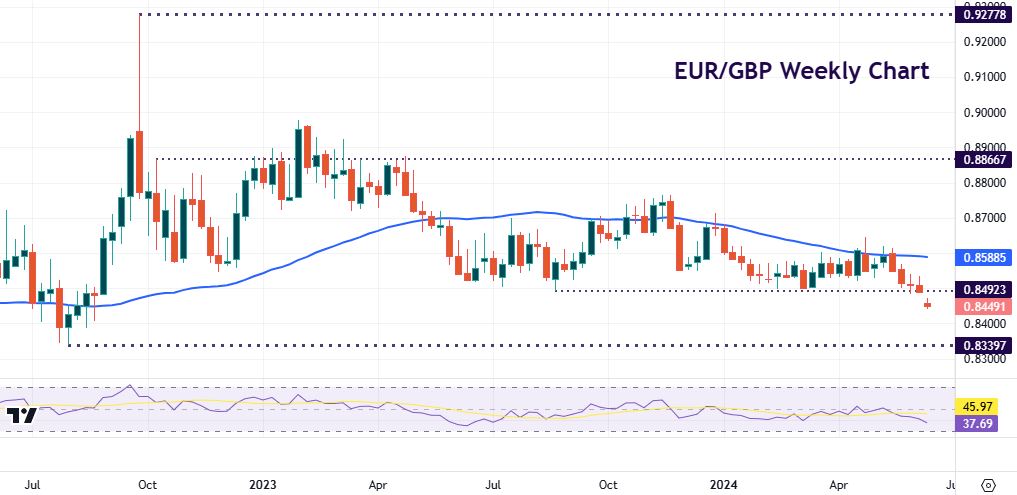Stocks post more all-time highs, euro drops on political concerns

Headlines
* Political heat gives central bankers pause for thought on rate cuts
* EUR/USD hits over four-week low after French President calls snap election
* USD rises as markets look to “Super Wednesday” with US CPI and FOMC
* Gold holds steady after biggest sell-off in over three years
FX: USD has built on gains from Friday’s strong Non-Farm Payroll report. The Dollar Index has reclaimed this year’s bullish trendline, with its high euro weighting (56-57%) helping. The NFP data showed a strong headline and wage growth, but the jobless rate ticked up to 4%. That is another sign the labour market is softening and something the Fed has become more sensitive to. There is a minor Fib retracement level at 105.25 which acted as resistance on Monday.
EUR was hit by European election worries, falling to over a one-month low. Political instability, with far-right parties gaining traction, resulted in a snap election being called in France. This all adds to deficit risk, highlighted by S&P’s recent downgrade of France’s sovereign credit rating. ECB President was also on the wires saying the bank could wait several meetings between rate cuts. Firm support lies in the 1.0675/1.0725 support zone.
GBP was mid-pack in the majors’ stakes, dipping below 1.27 before settling above. Election noise rumbles on with the desire for change still high. Political party manifestoes are revealed this week, but won’t change the general direction of travel. Support sits around 1.2675 which helped prices in late May too.
USD/JPY was little changed, steadying around 157. Focus is on Treasury yields and “Super Wednesday” when US CPI is released, plus the FOMC meeting. The BoJ meeting is the following day. Resistance is 157.67/71.
AUD gained modestly despite relatively soft risk appetite. Prices are just about back to the recent range after falling sharply on Friday’s NFP report. CAD has built on the push higher on Friday, though gave back some gains late on. Bulls will aim for 1.38 and beyond with strong resistance in this area. Contrasting central bank stances are likely to support the pair for some time.
US Stocks: Indices posted modest gains. But that did mean the S&P 500 and Nasdaq 100 did close at fresh, record highs. The S&P 500 finished up 0.26% at 5,360. The Nasdaq 100 settled higher by 0.3% at 19,056. The Dow closed in the green by 0.18% at 38,868. Energy and utilities led the gains with financials and consumer staples lagging. Megacaps were mixed with Nvidia higher by 1.3%, Meta up 1.6% while Apple and Alphabet were lower.
Asian Stocks: APAC futures are mixed. Asian stocks traded mixed with an eye on the week’s big risk events. There were also multiple holidays in Australia, China, and Hong Kong. The Nikkei 225 advanced due to more yen weakness and upwardly revised GDP data.
Gold steadied after the huge day of selling after the US jobs report. Prices closed down 3.45%, the precious metal’s worst day since November 2020. There is strong support from the lows in early May at $2277.
Day Ahead – UK Wages
Consensus expects the jobless rate to stay steady at 4.3%. However, this data may be looked through as there have been reliability issues. Wages are the key metric and likely to remain elevated. Average weekly earnings are predicted to stay at 5.7% with the ex-bonuses figure potentially ticking higher above 6%. The latter is due to the roughly 10% rise in the National Living Wage. The BoE have been looking for a big drop in wages to 5.1% in Q2.
This is one of the last big releases before next Thursday’s BoE meeting, and CPI figures which are released the day before. Services inflation is the key measure for policymakers. But wages have been important as a forward-looking indicator. Further evidence of a cooler labour market would be a boon for the MPC.
Chart of the day – EUR/GBP gaps lower
The EU elections saw sharp moves in some euro crosses on Monday. But despite advances by the far right, support for the single currency remains strong. There shouldn’t be any existential threat, but near-term uncertainty. On the flip side, debate at the Bank of England is focused on the timing of rate cuts. Slower than expected April disinflation and a surprise general election on July 4 suggest that a June move, in line with the ECB, looks improbable.
EUR/GBP has recently been testing the 2023 and 2024 lows near 0.85. Euro weakness eventually pulled the trick after French president Macron called snap elections following a weak showing in EU elections. Strong UK data and more hawkish BoE could keep prices below the long-term support/resistance, with eyes on 0.84 and 0.8339.

